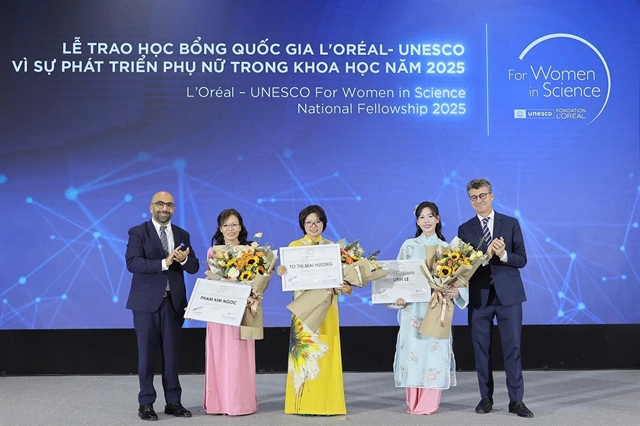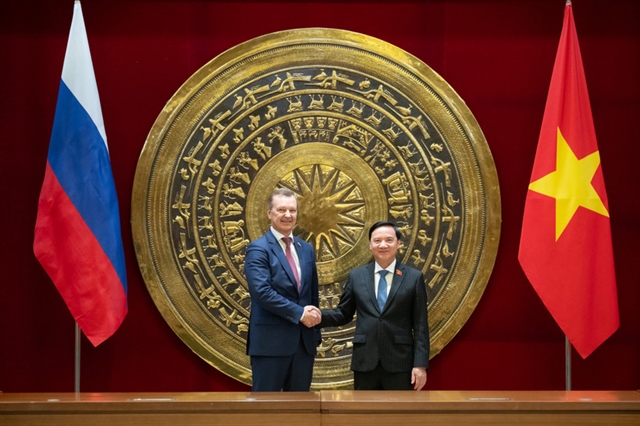 Society
Society

 |
| Chairman of HCM City People’s Committee Nguyễn Văn Được (right) and Chairman of CT Group Trần Kim Chung in the unveiling ceremony. — VNA/VNS Photo |
HÀ NỘI — Six months after its launch, Resolution 57 is proving to be a game-changer for Việt Nam’s tech landscape, giving local businesses a powerful push to dive deeper into core technologies and aim for long-term technological self-reliance.
The policy, issued by the Politburo, has helped fuel a fast-growing innovation ecosystem across the country. The country is now home to 858 science and technology enterprises, 45 high-tech companies and more than 73,000 digital technology firms.
What stands out is the strong involvement of major domestic tech players - proof that Resolution 57 is gaining traction not just among policymakers but across the broader business community.
The resolution has sparked a new wave of investment, research and development, transitioning many companies from simply using existing technology to actively mastering it.
One of the clearest examples of this shift is CT Group, which has taken bold steps to bring the resolution’s vision to life. At a recent review conference, the company unveiled the first Vietnamese-developed ADC chip - a crucial component that was designed and completed in just six months, a process that normally takes about two years.
The chip, which can be used in defence, AI, UAVs and smart devices, is a key part of CT Group’s broader strategy to build Việt Nam’s capabilities in chip design. The company is setting up a dedicated chip design house focused on AI, IoT, and chips for strategic sectors like 5G/6G, UAVs, and national defence.
"This is our first ADC chip design, and it’s a big deal for Việt Nam," said Trần Kim Chung, Chairman of CT Group.
"Normally, it would take two years to make, but we pushed hard and finished it in six months to keep up with the momentum of Resolution 57. That shows how powerful and motivating this policy really is."
CT Group has also added six strategic sectors to its national product line-up: semiconductors, 6G telecommunications, UAVs, gene and cell therapy, frontier space economy and digital transformation. Its Digital Twin 15 project is creating a major data infrastructure backbone for the country’s national data centre.
Looking further ahead, the company aims to take the lead in nine core 4.0 technologies, including AI, quantum computing, carbon credits, electric vehicles, and renewable energy.
It’s also expanding partnerships with tech players in the US, China, Indonesia, and other advanced markets to transfer and localise technology suited to Việt Nam’s needs.
Meanwhile, other major enterprises are stepping up. Viettel, a key player in both defence and technology, has reaffirmed its commitment to innovation as a pillar of sustainable growth.
Tào Đức Thắng, Chairman and CEO of Viettel Group, said the company views Resolution 57 as a strong catalyst for its development.
"We’ve studied the resolution carefully and believe Viettel has a central role to play in making it a reality," he said.
Viettel is currently focused on mastering core technologies in telecommunications, AI, big data and 5G/6G networks. The company is also helping to build digital infrastructure and platforms that support the government, businesses, and the general public in their digital transformation efforts.
Another leading state-owned enterprise, VNPT, has been identified as a 'frontline pioneer' in implementing Resolution 57.
The company has focused on three top priorities: investing in R&D, especially in AI and 5G/6G; building national digital infrastructure, including data centres, smart operation centres (IOC), 3D mapping, and urban simulation systems; and developing high-quality tech talent through training programmes and partnerships with top universities, as well as attracting international experts.
Resolution 57 places a strong emphasis on 'technological self-reliance', a term that appears repeatedly in the document. In today’s volatile global tech environment, mastering core technologies is not just a national goal; it’s a matter of economic security and international competitiveness.
For Vietnamese companies, especially in the tech sector, becoming self-reliant in technology is no longer optional. Relying on foreign technologies can leave them vulnerable to supply chain disruptions, high costs, and limited innovation. By contrast, controlling their own tech destiny allows firms to be more agile, creative and globally competitive.
Resolution 57 offers a clear direction and long-term vision. It gives businesses the confidence to invest in areas that require significant resources and carry high risk, but also offer high potential for breakthroughs.
Việt Nam’s journey toward mastering core technology and achieving tech independence is still in its early stages and full of challenges. But the resolution has already achieved one of its most critical goals: changing the mindset of Vietnamese businesses.
It has encouraged them to believe in their capabilities, take risks, and commit to building long-term value.
The early signs are promising: from the surge in digital and science-tech enterprises to the emergence of a homegrown R&D ecosystem. These developments are laying the foundation for Việt Nam to make a major leap forward in the years to come. — VNS




